គេហទំព័រយើងខ្ញុំបានចុះផ្សាយអំពី ប្រវត្តិ និងអត្ថន័យព្រះរាជពិធីច្រត់ព្រះនង្គ័លក្នុងសង្គមខ្មែរ និងបណ្តាប្រទេសខ្លះនៅអាស៊ីអាគ្នេយ៍រួចហើយ ក្នុងឱកាសនេះខ្ញុំសូម បង្ហាញទិដ្ឋភាពពាក់ព័ន្ធខ្លះៗនៃព្រះរាជពិធីច្រត់ព្រះនង្គ័លក្នុងសង្គមខ្មែរ ផ្អែកលើចម្លាក់ គំនូរ និងរូបថតនានា។ បំណងនៃការបង្ហាញនេះ គឺដើម្បីចូលរួមមួយផ្នែកតូច ឱ្យឃើញពីលំអានខ្លះដែលខ្មែរយល់ថាជាឫសគល់នៃទំនៀមព្រះរាជពិធីច្រត់ព្រះនង្គ័ល។ ទន្ទឹមនឹងនោះខ្ញុំសូមសង្ខេបសារបានព្រះរាជពិធីនេះ ដែលតែងប្រារព្ធជាប្រក្រតីចាប់ពីក្រោយរាជ្យព្រះករុណាព្រះបាទ នរោត្តម សីហនុ ព្រះបរមរតនកោដ្ឋ រហូតដល់សព្វថ្ងៃ។
បើពោលក្នុងក្របខណ្ឌស្រាវជ្រាវ គេពុំអាចកំណត់ដាច់ណាត់ថា ព្រះរាជពិធីច្រត់ព្រះនង្គ័លក្នុងសង្គមខ្មែរចាប់ប្រារព្ធពីត្រឹមណាឡើយ។ ប៉ុន្តែគេយល់ថា គោលគំនិតធំនៃពិធីនេះប្រហែលចាប់ផ្តើមតាំងពីខ្មែរជ្រួតជ្រាបអារ្យធម៌ឥណ្ឌា។ ជាក់ស្តែង យ៉ាងហោចណាស់មានរឿងទេពកថាពីរដែលខ្មែរស្គាល់គឺ រាមកេរ្តិ៍ និងមហាភារត។ បើលើកយករឿងរាមកេរ្តិ៍ជាអំណះអំណាង គេពន្យល់ថានៅត្រង់វគ្គដែលព្រះបាទជនក ព្រះមហាក្សត្រនៃនគរមិថិលាយាងច្រត់ព្រះនង្គ័ល ហើយប្រទះឃើញព្រះនាងសីតានៅនឹងអាចម៍បំណះ គឺជាប្រភពនៃព្រះរាជពិធីច្រត់ព្រះនង្គ័ល។ ក្នុងរឿងមហាភារត គេសំអាងត្រង់ចម្លាក់ព្រះពលទេពកាន់នង្គ័លជាកេតនភ័ណ្ឌ ដែលឃើញវត្តមានតាំងពីមុនសម័យអង្គរ។ បដិមាទេពអង្គនេះ ឃើញវត្តមាន ដល់សម័យអង្គរ និងបន្តរហូតមកដល់សម័យកណ្តាលផង។ ក្នុងសម័យកណ្តាល មន្រ្តីទទួលខុសត្រូវវិស័យកសិកម្មមានងារជា “ឧកញ៉ាពលទេព” ហើយច្បាប់គ្រប់គ្រងវិស័យកសិកម្មឈ្មោះថា “ក្រមពលទេព”។ និមិត្តរូបនេះ គេឃើញជាប់ក្នុងទំនៀមខ្មែរដល់សព្វថ្ងៃ តាមរយៈទង់ឯកធំក្នុងក្បួនហែព្រះរាជពិធីច្រត់ព្រះនង្គ័ល ដែលមានរូបព្រះពលទេពឈរកាន់នង្គ័ល។ រីឯក្នុងព្រះពុទ្ធសាសនា គេយល់ថាព្រះរាជពិធីច្រត់ព្រះនង្គ័ល គឺប្រារព្ធតាមពុទ្ធប្រវត្តិ ត្រង់ពេលព្រះបាទសុទ្ធោទន៍យាងចេញច្រត់ព្រះនង្គ័ល ដោយមានព្រះវត្តមានព្រះសិទ្ធត្ថ។ គ្រានោះ ព្រះសិទ្ធត្ថទ្រង់បានធ្វើសមាធិពិចារណាអំពីសត្វគោដែលប្រឹងប្រែងអូសនង្គ័លយ៉ាងហត់នឿយ។
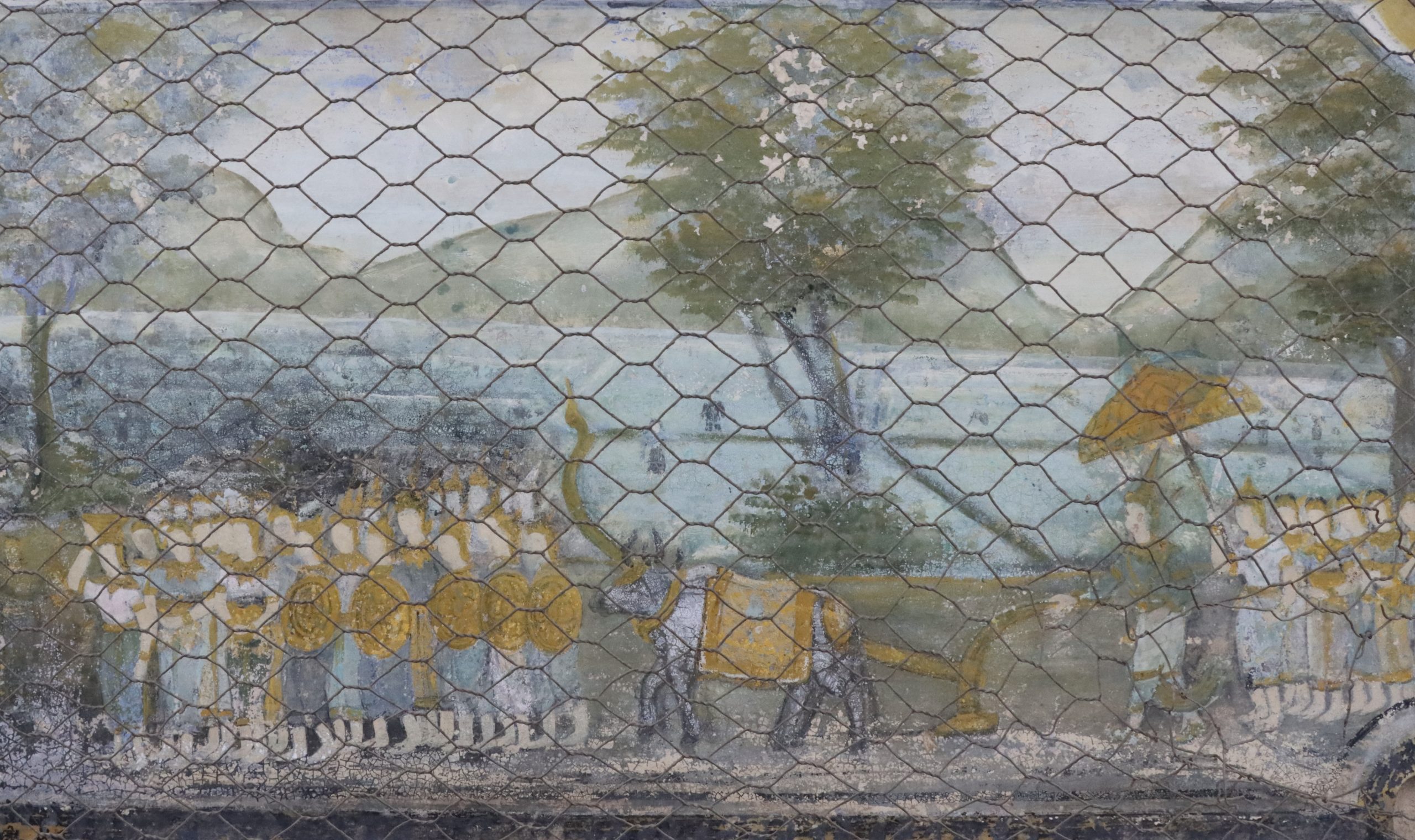
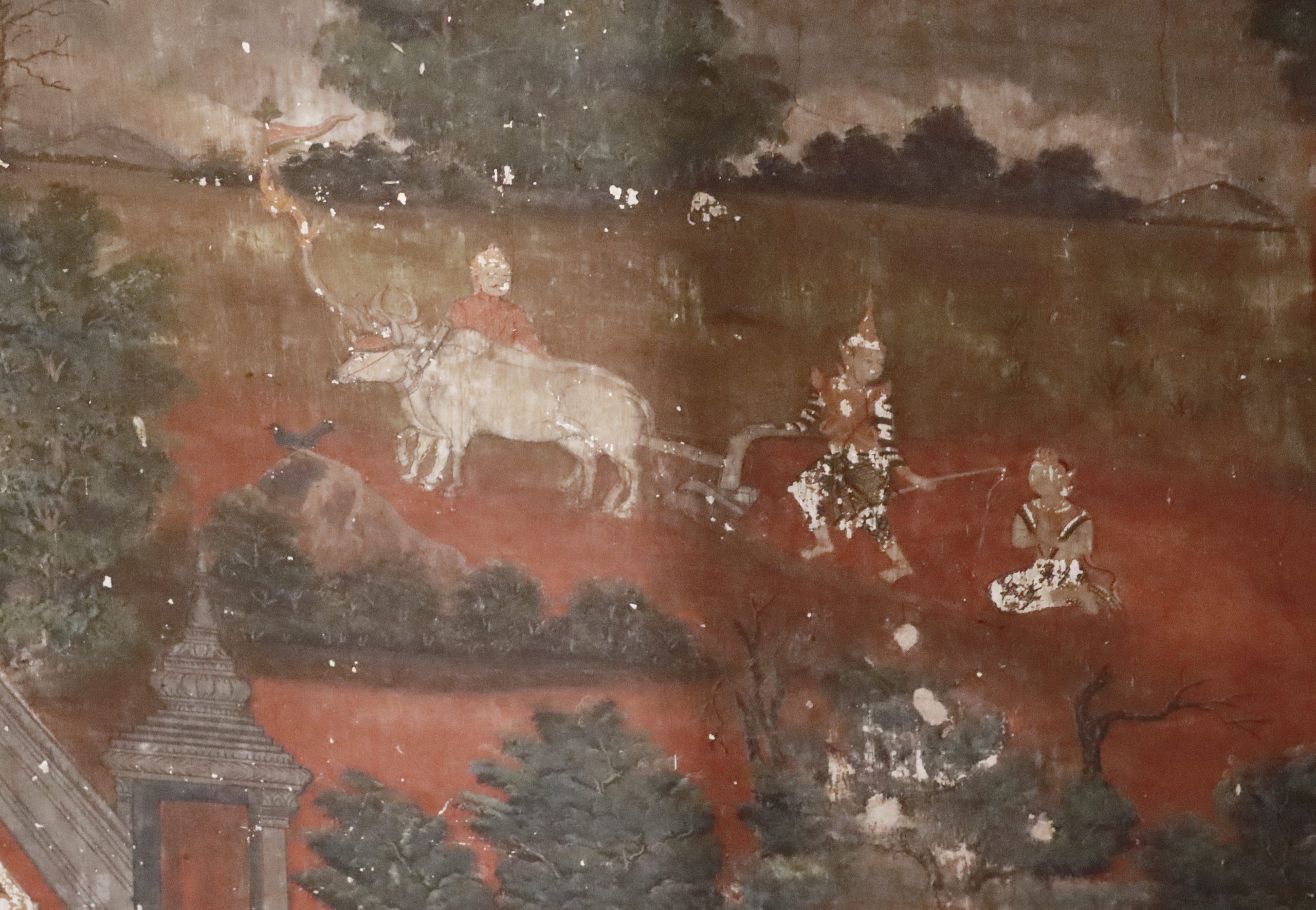
ចាប់ពីសម័យសង្គមរាស្រ្តនិយម ក្នុងរាជ្យ ព្រះករុណាព្រះបាទ នរោត្តម សីហនុ ព្រះបរមរតនកោដ្ឋ ទ្រង់បានចេញច្រត់ព្រះនង្គ័លផ្ទាល់ព្រះហស្ថរបស់ព្រះអង្គនៅទីព្រះស្រែ ស្ថិតនៅក្នុងបរិវេណព្រះលានជល់ដំរីនៃអតីតក្រុងអង្គរធំ ខេត្តសៀមរាប និងនៅខេត្តស្វាយរៀង។ ក្នុងគ្រានោះ និមិត្តរូបនៃព្រះរាជពិធីច្រត់ព្រះនង្គ័ល ក៏ឃើញប្រើប្រាស់ផ្សព្វផ្សាយនៅលើតែមប្រៃសណីយ៍ផងដែរ (រូបលេខ១១)។ ប៉ុន្តែក្រោយមក ព្រះករុណាព្រះបាទ នរោត្តម សីហនុ ព្រះបរមរតនកោដ្ឋ ទ្រង់តែងចាត់ព្រះរាជតំណាងច្រត់ព្រះនង្គ័លជំនួសព្រះអង្គ រហូតជាប់ជាទំនៀមដល់សព្វថ្ងៃ។
តាមទំនៀមក្នុងព្រះរាជពិធីទ្វាទសមាស ព្រះរាជពិធីច្រត់ព្រះនង្គ័លក្នុងសង្គមខ្មែរតែងប្រារព្ធជាប្រក្រតី ចាប់ពីថ្ងៃ១រោច ដល់ថ្ងៃ៤រោច ខែពិសាខ។ ពីថ្ងៃ១រោច ដល់ថ្ងៃ៣ឋរោច ក្រុមបាគូតែងធ្វើកិច្ចជាប្រចាំតាមទំនៀមនៅទីព្រះស្រែ។ លុះដល់ថ្ងៃ៤រោច ព្រះមហាក្សត្រទ្រង់តាំងមន្រ្តីជាន់ខ្ពស់ណាម្នាក់ឱ្យធ្វើជាស្តេចមាឃ ហើយភរិយាធ្វើជាមេហួ ដោយយកម្សៅក្រអូបមកចឺមលើថ្ងាសជាកិច្ចសន្មត ចេញច្រត់ព្រះនង្គ័ល។ ស្តេចមាឃស្លៀកសំឡុយចរបាប់ ពាក់អាវផាយ រីឯមេហួក៏ស្លៀកសំឡុយចរបាប់ ពាក់អាវរឹបរាង និងពាក់ស្បៃឆៀងពីលើ។
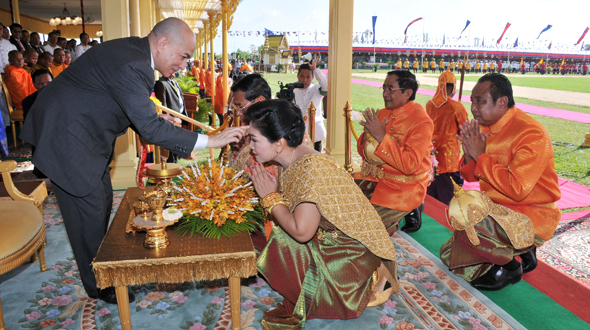
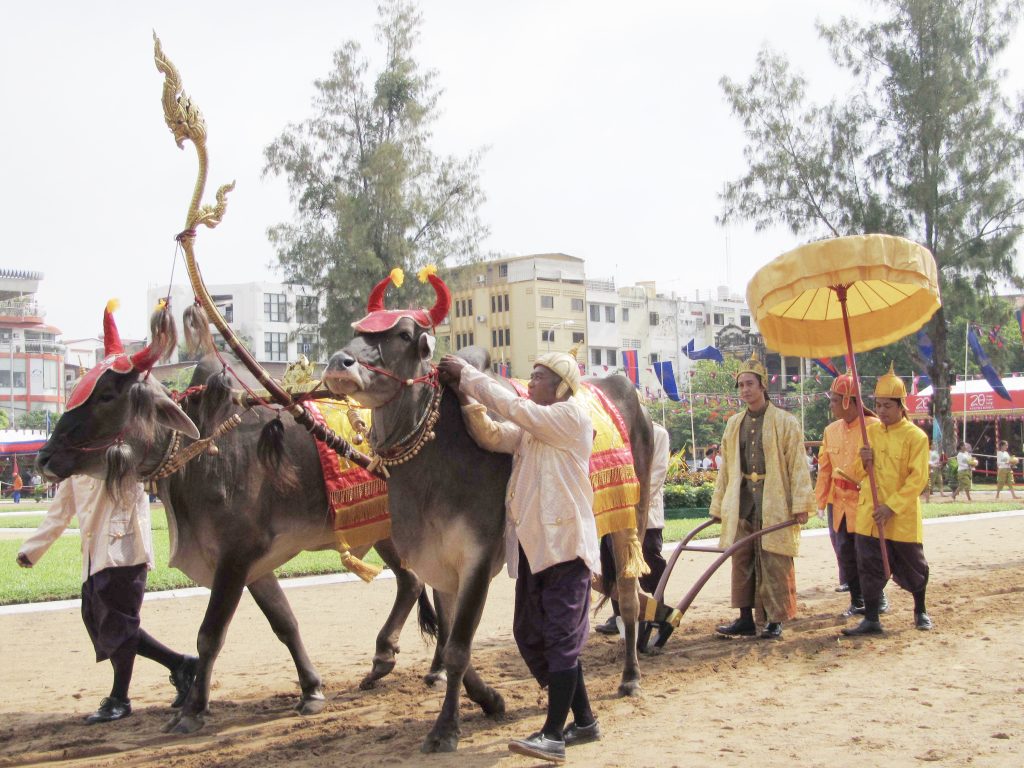
ក្នុងព្រះរាជពិធីច្រត់ព្រះនង្គ័លនៅខេត្តតាកែវ ឆ្នាំ២០១៩ (ប្រភព៖ norodomsihamoni.org)
ព្រះអង្គម្ចាស់ នរោត្តម ចក្រាវុឌ្ឍ និងព្រះមហាក្សត្រីយ៍ ស៊ីសុវត្ថិ ចាន់ស៊ីដា យាងជាស្តេចមាឃ និងមេហួ ក្នុងព្រះរាជពិធីច្រត់ព្រះនង្គ័ល ប្រារព្ធនៅទីព្រះស្រែវាលព្រះមេរុ
បន្ទាប់ពីព្រះមហាក្សត្រតែងតាំងតាមទំនៀមរួចស្រេចបាច់ហើយ ស្តេចមេឃត្រូវចូលទៅថ្វាយបង្គំព្រះចន្ទី តាំងនៅរោងមណ្ឌលទិសនិរតី មុននឹងចាប់ដំណើរការច្រត់ព្រះនង្គ័ល។ នង្គ័លច្រត់នាំមុខហៅថា “នង្គ័លយោង” នង្គ័លកណ្តាលកាន់ដោយស្តេចមាឃ និងមាននង្គ័លមួយទៀតនៅខាងក្រោយ ឯគោទាំងបីនឹមនោះឈ្មោះថា “គោឧសភរាជ”។ រីឯមេហួ ត្រូវដើរតាមក្រោយនង្គ័លទី៣ ហើយព្រាចគ្រាប់ពូជផ្សេងៗដូចជា ល្ង សណ្តែក ពោត និងស្រូវជាដើម។ ដំណើរច្រត់ព្រះនង្គ័លនេះ ចេះតែប្រព្រឹត្តិទៅដោយមានបាគូជាអ្នកដឹកនាំ ដើរតាមទិសទក្ខិណាព័ទ្ធ (ព័ទ្ធស្តាំ)។ លុះគ្រប់បីជុំហើយ គេតែងលែងគោឧសភរាជទាំងនោះឱ្យព្រាហ្មណ៍ប្រោះព្រំ និងផ្សងអំពីផលដំណាំផ្សេងៗសម្រាប់រដូវកាលធ្វើកសិកម្មថ្មីនេះ។ វត្ថុដែលយកទៅផ្សងនឹងគោឧសភរាជនោះមានប្រាំពីរមុខគឺ ស្រូវ ពោត សណ្តែក ល្ង ស្មៅ ទឹក និងស្រា។ ប្រសិនបើគោឧសភរាជបរិភោគគ្រាប់ពូជណាមួយ ទំនាយថាដំណាំនោះនឹងបានផលល្អ ហើយបើគោឧសភរាជបរិភោគទឹក ទំនាញថានឹងមានភ្លៀងធ្លាក់បរិបូរណ៍។ ប៉ុន្តែផ្ទុយទៅវិញ ប្រសិនបើគោឧសភរាជបរិភោគស្មៅស្រស់ នោះទំនាយថាស្រុកទេសនឹងកើតមានជំងឺលើសត្វពាហនៈ។ បើគោឧសភរាជបរិភោគស្រា ទំនាយថាស្រុកទេសនឹងកើតមានមនុស្សពាល ចោរលួចឆក់ប្លន់ និងអសន្តិសុខក្នុងសង្គម។ ដោយឡែកគេសង្កេតឃើញប្រជាកសិករ តែងនាំគ្នាប្រមូលគ្រាប់ស្រូវ ពោត សណ្តែក និងល្ង ដែលបានព្រាចទៅលើដី និងសល់ពីការផ្សងនោះ យកទៅលាយជាមួយគ្រាប់ពូជរបស់ខ្លួន ដោយមានជំនឿថានឹងធ្វើឱ្យដំណាំដាំដុះសម្រាប់ឆ្នាំថ្មីទទួលបានផ្កាផ្លែល្អប្រសើរ។
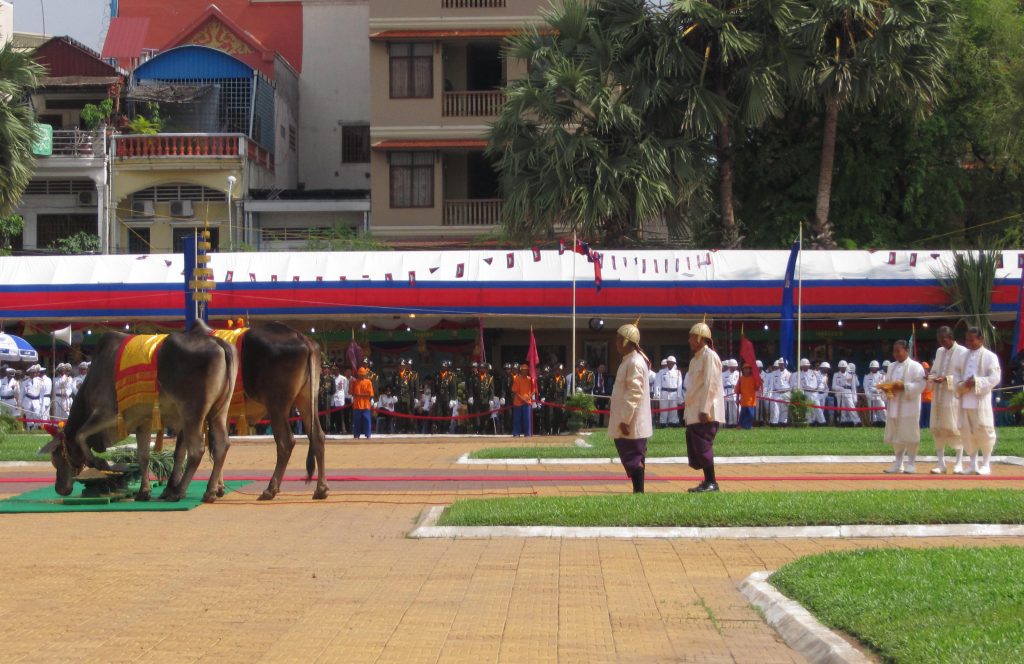

ក្រោយបានសន្តិភាព ព្រះរាជពិធីច្រត់ព្រះនង្គ័លក៏ចាប់ផ្តើមប្រារព្ធតាមប្រពៃណីឡើងវិញ។ ក្នុងឆ្នាំ១៩៩៣ បានរៀបចំឡើងនៅក្នុងបរិវេណពហុកីឡដ្ឋានជាតិអូឡាំពិក ហើយចាប់ពីឆ្នាំ១៩៩៤ រហូតមក ព្រះរាជពិធីនេះតែងរៀបចំប្រារព្ធនៅវាលព្រះមេរុ ក្បែរព្រះបរមរាជវាំង (ឆ្នាំ២០១០ ប្រារព្ធនៅសៀមរាប)។ ប៉ុន្តែចាប់ពីក្រោយ ព្រះករុណាព្រះបាទ នរោត្តម សីហនុ ព្រះបរមរតនកោដ្ឋ សោយព្រះទិវង្គត គេសង្កេតឃើញព្រះរាជពិធីច្រត់ព្រះនង្គ័ល តែងរៀបចំប្រារព្ធតាមបណ្តាខេត្តដូចជា ឆ្នាំ២០១៣ នៅខេត្តកំពង់ចាម ឆ្នាំ២០១៤ នៅខេត្តកណ្តាល ឆ្នាំ២០១៥ នៅខេត្តបាត់ដំបង ឆ្នាំ២០១៦ នៅខេត្តសៀមរាប ឆ្នាំ២០១៧ នៅខេត្តព្រៃវែង ឆ្នាំ២០១៨ នៅខេត្តស្វាយរៀង ឆ្នាំ២០១៩ នៅខេត្តតាកែវ និងចាប់ពីឆ្នាំ២០២០ មកព្រះរាជពិធីនេះត្រូវបានផ្អាកដោយសារវិបត្តិកូវីដ-១៩៕
———————————–
The view of the Royal Ploughing Ceremony in Khmer society
The history and the meaning of Royal Ploughing in Khmer and Southeast Asian society were published earlier on the website. This article will focus on the Royal ploughing ceremony in Khmer society illustrated in relief, painting, and some photos. Importantly, it will be addressed the ceremony from the reign of King Norodom Sihanouk.
It is not known when the Royal ploughing ceremony was celebrated in Khmer society. However, it is known that the concept of the ceremony might come from India. At least, when Khmer knew Ramayana and Mahabharata. Based on Ramayana, King Janaka of Mithila kingdom did ploughing and found Sita. Thus, this event became the source of the Royal ploughing ceremony. However, based on Mahabharata, Balarama holds a plough as the attribute. The statue of Balarama holds a plough found from the pre-Angkorian period to the middle period. In the middle period, the official who is charged with agriculture is named “Oknha Baladeva” and the law to control agriculture is called “Kram Baladeva”. Presently, the symbol of “Preah Baladeva” is seen standing and holding a plough on the main pennant of the Royal ploughing ceremony. In Buddhism, the Royal Ploughing ceremony is known as taking from the event in Buddha’s life. King Sodhodhana did ploughing with the present of Siddhartha. At that time, Siddhartha imagined the working of the cows that pull the plough. Since the Sangkum Reastr Niyum period and during the reign of King Norodom Sihanouk, King Norodom Sihanouk did ploughing in front of the terrace elephant in Angkor Thom, Siem Reap and Svay Rieng province. The image of the ceremony was printed on the stamp. Later, the King’s commandment for a representative, and continues to the present.
According to the twelve months ceremony (Tvea Tosa Meas), generally, the ceremony of Royal ploughing celebrates from 1st Roch to 4th Roch of Visaka in the Luna calendar. From 1st to 3rd Roch, a group of Barkou (Brahmin or Kuru) celebrated rituals at Preah Sre (royal/holy rice field). On the 4th Roch, the King orders an official to be Sdach Meak and his wife as Me Hou. To begin, a dot of powder is put on the forehead of the Me Hou and Sdach Meak. Sdach Meak wears a long silky skirt and a long gown.
In continue, Sdach Meak goes to pay respect or worship Preah Chanti that is installed in the shrine in the southwest direction before leaving to plough. The first plough is called Nangkorl Yeang, and a plough in middle holds by Sdach Meak. Another plough will be followed. The three pairs of cows are called Ko Usuphareach. Me Hou will be walking behind the last plough and throwing the crops. The ploughing led by Barkou respects the right side. After three rounds, the cows will be released to eat rice, corn, bean, sesame, grass, water, and wine. It is believed that the food that was eaten the most will grow more. If the cows drink water, the rain will be enough for growth. If the cows ate the grass, there will be more diseases and effect more to the animals. If the cows drink wine, the societies will have many bad people, criminals, etc. After the ceremony, farmers always go into the rice field and pick the crops to mix with their crops for growth when the time comes. It is believed to have a good harvest.
After the war, Royal ploughing ceremony started again. In 1993, the ceremony was celebrated in the stadium, Olympic. Since 1994, it has celebrated in Veal Preah Me in the north of the Royal Palace. However, in 2010 celebrated in Siem Reap, terrace elephant. However, after the death of King Norodom Sihanouk, the ceremonies were celebrated in different provinces. However, in 2020 or during the pandemic of Covid-19, the ceremony has been canceled.
អត្ថបទដើម៖ ហៀន សុវណ្ណមរកត






